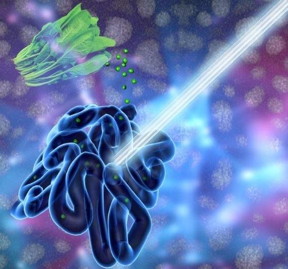Veggie juice that illuminates the gut: The medical imaging drink, developed to diagnose and treat gastrointestinal illnesses, is made of concentrated chlorophyll, the pigment that makes spinach green
The pigment that gives spinach and other plants their verdant color may improve doctors' ability to examine the human gastrointestinal tract. Veggie juice that illuminates the gut: The medical imaging drink, developed to diagnose and treat gastrointestinal illnesses, is made of concentrated chlorophyll, the pigment that makes spinach green
That's according to a study, which describes how chlorophyll-based nanoparticles suspended in liquid are an effective imaging agent for the gut.

A new University at Buffalo-led study suggests that chlorophyll-based nanoparticles are an effective imaging agent for the gut.
"Our work suggests that this spinach-like, nanoparticle juice can help doctors get a better look at what's happening inside the stomach, intestines and other areas of the GI tract," says Jonathan Lovell, PhD, assistant professor in the Department of Biomedical Engineering at UB's School of Engineering and Applied Sciences, and the study's corresponding author.
To examine the gastrointestinal tract, doctors typically use X-rays, magnetic resonance imaging or ultrasounds, but these techniques are limited with respect to safety, accessibility and lack of adequate contrast, respectively.
Doctors also perform endoscopies, in which a tiny camera attached to a thin tube is inserted into the patient's body. While effective, this procedure is challenging to perform in the small intestine, and it can cause infections, tears and pose other risks.
The new study, which builds upon Lovell's previous medical imaging research, is a collaboration between researchers at UB and the University of Wisconsin-Madison. It focuses on Chlorophyll a, a pigment found in spinach and other green vegetables that is essential to photosynthesis.
In the laboratory, researchers removed magnesium from Chlorophyll a, a process which alters the pigment's chemical structure to form another edible compound called pheophytin. Pheophytin plays an important role in photosynthesis, acting as a gatekeeper that allows electrons from sunlight to enter plants.
Next, they dissolved pheophytin in a solution of soapy substances known as surfactants. The researchers were then able to remove nearly all of the surfactants, leaving nearly pure pheophytin nanoparticles.
The drink, when tested in mice, provided imaging of the gut in three modes: photoacoustic imaging, fluorescence imaging and positron emission tomography (PET). (For PET, the researchers added to the drink Copper-64, an isotope of the metal that, in small amounts, is harmless to the human body.)
Additional studies are needed, but the drink has commercial potential because it:
● Works in different imaging techniques.
● Moves stably through the gut.
● And is naturally consumed in the human diet already.
● In lab tests, mice excreted 100 percent of the drink in photoacoustic and fluorescence imaging, and nearly 93 percent after the PET test.
"The veggie juice allows for techniques that are not commonly used today by doctors for imaging the gut like photoacoustic, PET, and fluorescence," says Lovell. "And part of the appeal is the safety of the juice."
Source: Nanotechnology Now
- 303 reads
Human Rights
Ringing FOWPAL’s Peace Bell for the World:Nobel Peace Prize Laureates’ Visions and Actions

Protecting the World’s Cultural Diversity for a Sustainable Future

The Peace Bell Resonates at the 27th Eurasian Economic Summit

Declaration of World Day of the Power of Hope Endorsed by People in 158 Nations

Puppet Show I International Friendship Day 2020

